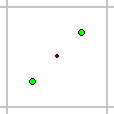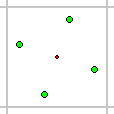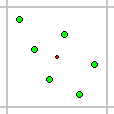ATi & nVidia Anti-Aliasing Performance
Anti-Aliasing quality and performance compared while using anisotropic filtering
Dezember 10, 2003 / by Leonidas / page 1 of 10 / translated by 3DCenter Translation Team
Introduction
Both ATi and nVidia like to present their anti-aliasing solutions as something miraculous - for example, that they are the best available on the market, or that they'd work with (virtually) no performance hit. Both companies use very different approaches: While ATi uses three multisampling modes, nVidia employs up to 10 different modes - depending on driver version -, of which most are combinations of supersampling and multisampling.
In most hardware reviews only few of these are benchmarked, simply because there isn't enough time for a more in-depth look. We want to make up for that with this article, which will exclusively look at the anti-aliasing performance of current ATi and nVidia graphics chips, while also keeping an eye on the performance of these modes. While doing so, our emphasis will be on the performance of the more rarely benchmarked anti-aliasing modes in comparison to the lower anti-aliasing modes as well as a general view on the overall performance characteristics.
Before actually benchmarking, we'll have to look at the differences in image quality of the tested modes, to see whether they are comparable. Unfortunately, between ATi and nVidia none really are. Even with 2x anti-aliasing, where ATi and nVidia use qually good subpixel masks, ATi has the advandage in offering gamma corrected anti-aliasing, which nVidia is incapable of with its current GeForceFX generation. Under closest scrutiny no anti-aliasing modes between ATi and nVidia are directly comparable. This has to be kept in mind for the following performance comparisons.
In advance we have to note that throughout this article, all chips were tested with 8x (nVidia) and 16x (ATi) anisotropic filtering respectively - also in tests without anti-aliasing. This happened solely on the reason of making the comparison itself more realistic. The idea was that if you switch on anti-aliasing on such a highend graphics chip, you will likely also choose to enhance texture quality with anisotropic filtering - simply because today's high end chips have no problem to do so. Of course, we could have benchmarked anti-aliasing alone without the anisotropic filtering, and this way could have achieved a possibly more precise result concerning anti-aliasing. But we think measuring with anisotropic filter is much closer to reality, because in most cases on highend graphics cards both features are used together.
The basis for ATi and nVidia does not change through the enabling of anisotropic filtering anyway, because both the cards we primarily tested - Radeon 9800 Pro 256MB and GeForceFX 5900 Ultra 256MB - achieve nearly identical performance under this setting. So this article will not measure the theoretical anti-aliasing performance (for which flyby benchmarks in Unreal Tournament 2003 would probably be best), rather concentrate only on the anti-aliasing performance in day-to-day gaming, where switching on the anisotropic filter should be standard already.
ATi Anti-Aliasing Modes
With ATi's R3x0 and RV3x0 generation of graphics chips (Radeon 9500/9600/9700/9800), the question about existing anti-aliasing modes is a quick one to answer: the Canadian graphics chip developer offers 2x, 4x and 6x gamma corrected multisampling in Direct3D as well as in OpenGL. ATi uses the following subpixel-masks and reaches image qualities as seen on the right, measured by the FSAA Tester (clicking on a thumbnail opens a larger image)
To sum it up, ATi offers good anti-aliasing choices, where every mode was optimised to get the maximum effect through intelligently chosen subpixel grid. In theory, the sampling positions of ATi's anti-aliasing are even programmable, but this possibilty doesn't exist in the Windows drivers so far. The only thing we might complain about is the lack of an 8x mode, since because of the rule of diminishing returns this would be required to get a significant increase in image quality versus the 4x mode while the quality gains to be had by using 6x versus 4x are rather small.

|

|








